July 26, 2024
Air Date: July 26, 2024
FULL SHOW
SEGMENTS

Kamala on Earth
View the page for this story
Vice President Kamala Harris has garnered more than enough delegates for the Democratic nomination for President. Hosts Steve Curwood and Jenni Doering review her record on the environment, which has included prosecuting cases against polluting oil companies, supporting a Green New Deal, and representing the US at UN climate meetings. (07:37)
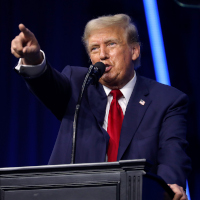
Trump on Earth
/ Marianne LavelleView the page for this story
The four years of the Trump Administration brought over a hundred regulatory rollbacks, the exit of the US from the Paris Climate Agreement, and a conservative dominated Supreme Court that is skeptical of environmental regulation. Inside Climate News Reporter Marianne Lavelle joins Hosts Steve Curwood and Jenni Doering to share insights from a former Trump EPA official, environmental policy experts and advocates about the environmental impacts of the Trump presidency and what a second one could bring. (13:50)

Listener Comments
View the page for this story
Letters are read from Living on Earth listeners concerned about an interview with Conservative Climate Caucus and Republican US Congress member Cliff Bentz of Oregon, with comments from Host Steve Curwood about First Amendment rights of free speech and free press, and the dangers of censorship. (03:27)
Water! Falls!
/ Mark Seth LenderView the page for this story
Living on Earth’s Explorer in Residence Mark Seth Lender muses on what waterfalls and volcanoes have in common, in transforming their elements of water and rock into something new. (02:23)
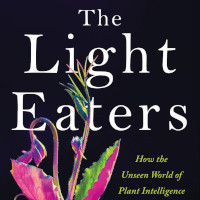
The Light Eaters
View the page for this story
A scientist who rappels down cliffs to hand-pollinate endangered plants. A vine that mimics the leaves of nearby species. Rice that crowds out strangers but leaves room for the roots of relatives. All of these are subjects of the book The Light Eaters by Zoë Schlanger, who tackles big questions of plant intelligence, consciousness, and communication. She joins Host Steve Curwood to talk about what we might discover when we look closely at the green life around us. (18:35)
Show Credits and Funders
Show Transcript
240726 Transcript
HOSTS: Steve Curwood, Jenni Doering
GUESTS: Zoë Schlanger
REPORTERS: Marianne Lavelle, Mark Seth Lender
[THEME]
CURWOOD: I’m Steve Curwood.
DOERING: And I’m Jenni Doering.
Environmental justice booster Kamala Harris jumps into the race for president.
HARRIS: And look, I care about the environment not because I have any particular desire to hug a tree, but I have a strong desire to hug a healthy baby. And this literally comes down to clean air and clean water.
CURWOOD: Also, astonishing revelations about plant intelligence and consciousness.
SCHLANGER: So they handed me tweezers, we're in this dark microscope lab, and I pinch the plant with the tweezers, and suddenly there's this green eminence glowing from the place that I've pinched this plant, then it starts traveling down its vein system. And within about two minutes, the entirety of this little plant had received the signal of my pinch.
CURWOOD: That and more, this week on Living on Earth—stick around!
[NEWSBREAK MUSIC: Boards Of Canada “Zoetrope” from “In A Beautiful Place Out In The Country” (Warp Records 2000)]
[THEME]
[NEWSBREAK MUSIC: Boards Of Canada “Zoetrope” from “In A Beautiful Place Out In The Country” (Warp Records 2000)]
[THEME]
Kamala on Earth
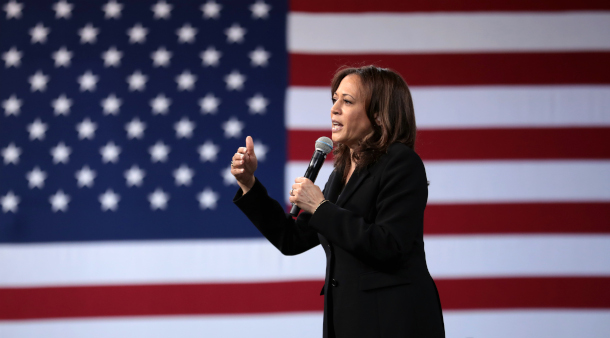
Vice President Kamala Harris has secured more than enough delegates for the Democratic presidential nomination. (Photo: Gage Skidmore, Flickr, CC BY SA 2.0)
CURWOOD: From PRX and the Jennifer and Ted Stanley Studios at the University of Massachusetts Boston, this is Living on Earth. I’m Steve Curwood.
And I’m Jenni Doering.
So Steve, with a lot of excitement, Vice President Kamala Harris has garnered a majority of delegates for the Democratic nomination for President to oppose Republican Donald Trump. You gotta say with President Biden’s decision not to run again, this race just got way more interesting. And there’s a lot one could say, but right now let’s consider the environment and climate change.
CURWOOD: Yeah, Jenni, though her career so far is in sharp contrast to Joe Biden’s.
For example, soon after law school he worked in some private law practices in Delaware, including one run by a prominent Republican. He then tried the defense side of criminal law, working as a public defender, and defied the odds when he won a local office and then a US senate seat by age 29. Kamala Harris started as a prosecutor right out of law school, working her way up the ranks and staying with the Democrats all along, ultimately winning elections as District Attorney and then California State Attorney General. At the local and state level she made her mark in a number of prosecutions, including environmental ones. As she recently told supporters at her campaign headquarters, she took on big oil companies, suing Chevron over hazardous waste and Conoco Phillips over gas station violations.
HARRIS: As District Attorney, to go after polluters, I created one of the first environmental justice units in our nation. (cheers) Donald Trump stood in Mar-a-lago and told big oil lobbyists he would do their bidding for a $1 billion campaign contribution…(boos).
DOERING: And Steve, while campaigning for the Senate seat vacated by Barbara Boxer in 2016, Attorney General Harris joined local prosecutors to bring criminal charges against operators of a failed oil pipeline that polluted roughly 100 miles of California beaches.

As Attorney General of California, Harris filed several lawsuits against corporations for environmental regulation violations. (Photo: Office of the Attorney General of California, Wikimedia Commons, Public Domain)
HARRIS: This case should serve as a stark reminder that any company that is operating in our state and transporting crude oil and doing it in a way that is irresponsible and in violation of the law will be held accountable. In this state, we value our environment. We value our pristine coastal communities, we value the precious wildlife and the oceans that we are proud to call a big part of California. And anyone who violates the law in endangering our wildlife in our oceans is going to be held accountable.
DOERING: Now once in the Senate, Kamala Harris was most visible when it came to the environment when she cosponsored the resolution calling for a Green New Deal. And she was to the left of Joe Biden on the Green New Deal in 2019 when she was campaigning in the New Hampshire presidential primary.
HARRIS: I am supporting the Green New Deal. We have to have goals. And we have to—it’s a resolution that requires us to have goals and think about what we can achieve and put metrics on it. Some of them we’ll achieve, some of them we won't, but if we don't aspire, we're not, we're gonna, this is gonna be a bad ending. And I hate to sound this way. I don't want to sound like an alarmist, but it is very real and it is within our power.
CURWOOD: And she stayed steady on the environment even as she had to brush away derision about her green concerns.

As a Senator for California, Harris was one of the first co-sponsors of the Green New Deal. (Photo: Becker1999, Wikimedia Commons, CC BY 2.0)
HARRIS: And look, I care about the environment not because I have any particular desire to hug a tree, but I have a strong desire to hug a healthy baby. And this literally comes down to clean air and clean water. And we have got to take this seriously and it is imminent as a threat unless we correct course and do some serious work on changing our behaviors and adapting to what we know we can do. It is within our power to do it.
CURWOOD: Of course history records that Kamala Harris dropped her campaign for president before any votes were cast, and ultimately she was tapped for vice president by Joe Biden. But even though Biden never called the Inflation Reduction Act part of a Green New Deal, at the end of the day it incorporated many of the concepts of the original resolution. And Vice President Harris echoed the Green New Deal when she spoke at Florida International University in 2022.
HARRIS: The climate crisis has exposed and intensified generations of economic and environmental inequities that have been present in communities across our nation. And our administration remains committed to addressing those inequities through environmental justice.
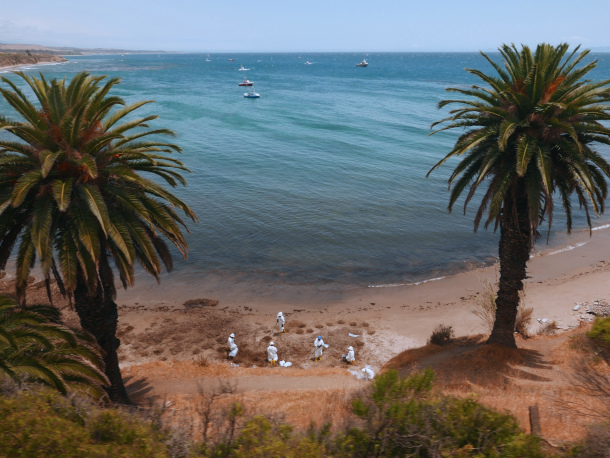
Workers clean up the 2015 oil spill that affected over 100 miles of California coastline. (Photo: Dreamyshade, Wikimedia Commons, CC BY-SA 4.0)
DOERING: And Kamala Harris took that theme into the international arena when she spoke at the 2023 UN climate summit in Dubai, two years after President Biden had returned the US to the Paris Climate Agreement.
HARRIS: The United States of America will once again be a global leader in the fight against the climate crisis. Since then, the United States has turned ambition into action. President Biden and I have made the largest climate investment in the history of our country and some have said the world: roughly a trillion dollars over the next 10 years.
DOERING: And at COP28 she detailed everything from clean energy investments to coastal resilience and forest protection.
HARRIS: Today we are demonstrating through action, how the world can and must meet this crisis. This is a pivotal moment. Our action collectively, or worse, our inaction will impact billions of people for decades to come. For as much as we have accomplished, there is still so much more work to do. And continued progress will not be possible without a fight.

Vice President Harris delivered remarks at COP28 in December 2023. (Photo: Office of the President of the United States, Wikimedia Commons, Public Domain)
CURWOOD: So, Jenni, one of the resources Joe Biden is giving Kamala Harris beyond his campaign organization is his vast set of personal contacts in the international arena.
That could make a difference for the climate emergency in the world, if she can successfully combine that with her drive for meaningful change as she navigates the entangled issues of emissions, fossil fuels and finance.
DOERING: All right, Steve, well I’m glad we’re getting down to the real issues at heart here. But there is one viral clip we haven’t played yet, and guess what? It’s about trees.
HARRIS: My mother used to - she would give us a hard time sometimes, and she would say to us, ‘I don’t know what’s wrong with you young people. You think you just fell out of a coconut tree?' [LAUGHS] You exist in the context of all in which you live and what came before you.
DOERING: And Steve, this is getting play all over TikTok and Instagram, with coconut tree emojis to boot. Kamala Harris just seems to be one of those public figures who’s highly “meme-able”, and that’s attracting a lot of attention from Gen Z. Some of whom are turning 18 just in time to vote this fall.
Madam Vice President, we are ready to help. pic.twitter.com/y8baSx44FL
— Brian Schatz (@brianschatz) July 22, 2024
CURWOOD: Right, Jenni and with the climate emergency now so evident with the heat waves and storms and fires, Kamala Harris seems poised to attract votes from the climate concerned of all ages. And should the early excitement about her candidacy translate into winning the White House, she could come into office with a Senate and House ready to move beyond the record-setting climate actions of the Biden-Harris administration.
Related links:
- Office of the Attorney General | “Attorney General Kamala D. Harris Announces Proposed $24.5 Million Settlement with Chevron Gas Station and Tank Owners”
- Los Angeles Times | “ConocoPhillips and Phillips 66 To Pay $11.5 Million In Pollution Case”
- Harris speaks at Delaware Headquarters, July 22, 2024
- Office of the Attorney General | “Attorney General Kamala D. Harris Announces Indictment of Plains All-American Pipeline on Criminal Charges Resulting from May 2015 Santa Barbara County Oil Spill”
- Harris announces criminal charges against Plains All-American Pipeline
- Resolution calling for a Green New Deal in 2019
- Harris speaks in New Hampshire 2019
- Harris speaks on the campaign trail 2019
- Harris speaks at Florida International University in August 2022
- Harris speaks at COP28 in Dubai, UAE
- Harris “Coconut Tree” quote
[MUSIC: Joe Pass, “Chloe” on Intercontinental, Edel Germany GmbH]
Trump on Earth
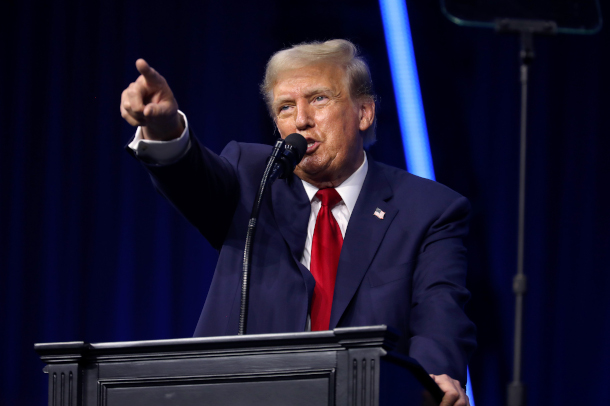
Former President Donald Trump speaking at The People's Convention on June 15 in Detroit. (Photo: Gage Skidmore, Flickr, CC BY-SA 2.0)
CURWOOD: Let’s take a look now at the environmental record and plans of the Republican nominee for President, Donald Trump. Marianne Lavelle of our media partner Inside Climate News reported on climate and environmental policy throughout the Trump presidency and she joins us now from Washington, D.C.
DOERING: Hi Marianne, welcome back to Living on Earth!
LAVELLE: Thank you, great to be here!
DOERING: So sou know, Donald Trump came into office in 2017 vowing to roll back various climate and environment regulations. So where should we begin?
LAVELLE: Well, let’s start with an especially memorable move, when he pulled the US out of the Paris Climate Agreement. I talked to Trump’s former chief of staff at EPA, Mandy Gunasekara, who described what it was like to be in “the room where it happened.”
GUNASEKARA: Early on, one of my first briefings with the President, I was with administrator Scott Pruitt, and the Chief of Staff at that time, and we went in, and we were sufficiently outnumbered in terms of, there were three of us representing, we were advocating getting out. And I would say the rest of the room with about 20 plus people had a lot of people that were in the camp of “we should stay in.” And then a strongly worded and heated debate ensued. But what the President would do in these situations is sit back and listen and ask probing questions that I believe resulted in him making really good consistent policy choices all throughout his administration, because he really did like to hear both sides of the argument.
CURWOOD: Sounds like the ‘pull out of Paris’ camp was way, way outnumbered, so Marianne, what swayed Trump to pull out?
LAVELLE: Ms. Gunasekara said it came down to concerns about how the Paris Agreement could affect the economy. There was a study by an oil and gas consulting firm sponsored by the US Chamber of Commerce that estimated the agreement would cost the US 2.7 million jobs by 2025.
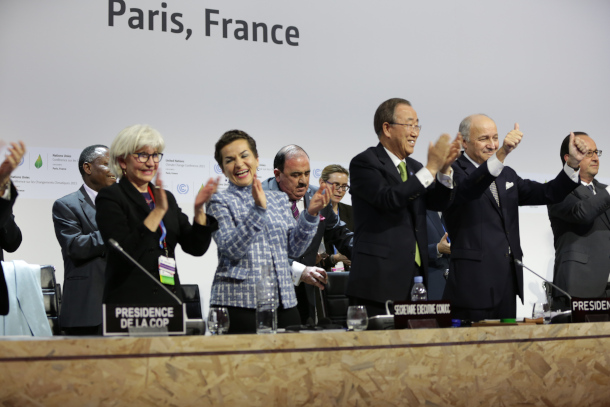
Adoption of the Paris Climate Agreement on 12 December, 2015. (Photo: UNclimatechange, Wikimedia Commons, CC BY 2.0)
GUNASEKARA: It broke down the impact that the Paris Climate Accord would ultimately have on some key industries and industries that the President cared a lot about. He really focused on bringing, and reinvigorating the life of the American worker, first with ensuring or growing the opportunity for a job, and then the affiliated community investments and growth alongside it. So, it really it came back to what is this going to do to American jobs?
CURWOOD: Well, Marianne, that certainly plays right into the concerns of conservative voters, huh?
LAVELLE: It does, but those job loss claims were unfounded. Since President Biden re-entered the Paris Agreement, the US has added 7.5 million jobs compared to the pre-Covid pandemic high during the Trump administration. Turning away from the Paris Accord was just one part of Donald Trump’s “America First” emphasis on pulling back from the rest of the world. But Samantha Gross, who directs the Energy Security and Climate Initiative at the Brookings Institution says this approach came at a cost.
GROSS: The real fallout from former President Trump removing us from the Paris Accord is that we really just lost our credibility internationally on climate issues. The US was no longer a respected party in international efforts to combat climate change. I mean, we really sort of, we didn't entirely fall off the face of the earth. We still sent delegations, but we weren't considered in any way seriously during that time.
LAVELLE: Meanwhile the administration was shifting to domestic concerns. Again, Mandy Gunasekara.
GUNASEKARA: At EPA, we had an affiliated agenda, what we called “back to basics,” which really was getting EPA back to focusing on cleaning up the air, cleaning up the water, addressing legacy pollution, and continuing to improve industrial efficiencies that lent itself to reduced greenhouse gases.
LAVELLE: And a couple of examples she mentioned were the updating of the Lead and Copper Rule and an action plan for PFAS or “forever chemicals”. But Tiernan Sittenfeld of the League of Conservation Voters rejected this claim that EPA got “back to basics” under Trump.
SITTENFELD: That's, it's nonsense. The Trump administration was the most anti-environmental, anti-climate, anti-public health administration we've ever had, by far. It was just breathtaking, the extent to which they rolled back protections for clean air, for clean water, for public lands, that led to more toxic pollution into communities all across this country, especially the frontline and the fence line and the communities of color that have been hit first and worst by toxic pollution by decades.
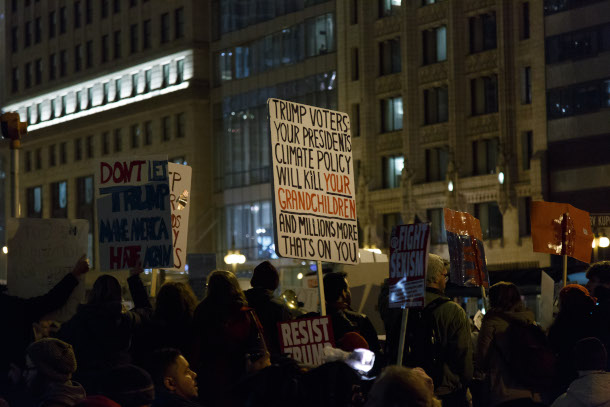
Protesters gathered in Chicago following the inauguration of Donald Trump in 2017. (Photo: Rob Walsh, Wikimedia Commons, CC0 1.0 UNIVERSAL)
[MUSIC: Joe Pass, “Chloe” on Intercontinental, Edel Germany GmbH]
DOERING: We’re talking with Marianne Lavelle of Inside Climate News and we’ll be back in a moment to talk about those regulatory rollbacks. Stay tuned to Living on Earth!
[MUSIC: Joe Pass, “Chloe” on Intercontinental, Edel Germany GmbH]
ANNOUNCER: Support for Living on Earth comes from Sailors for the Sea and Oceana. Helping boaters race clean, sail green and protect the seas they love. More information @sailorsforthesea.org.
[CUTAWAY MUSIC: Joe Pass, “Chloe” on Intercontinental, Edel Germany GmbH]
CURWOOD: It’s Living on Earth, I’m Steve Curwood.
DOERING: And I’m Jenni Doering.
We’re continuing our conversation with Marianne Lavelle of Inside Climate News about the environmental record of the Trump administration. So, Marianne, as I recall, regulatory rollbacks were a big focus of Donald Trump’s 2016 campaign.
LAVELLE: That’s right, Jenni. So Michael Gerrard, founder and director of the Sabin Center for Climate Change Law at Columbia, was ready.
GERRARD: On the day that Trump was inaugurated, we launched a website called the climate deregulation tracker to keep track of what he was doing. By the end of the administration, there were 176 entries on that tracker.
LAVELLE: There was everything from weakening methane emission rules for oil and gas, to amending coal ash regulations, to approving the Keystone XL and Dakota Access Pipelines. And a lot more. But Michael Gerrard says one rollback trumps them all.
GERRARD: The regulatory rollback under Trump that had the greatest impact on climate change was weakening the fuel economy standards. Motor vehicles are the largest source of greenhouse gas emissions in the United States. Under President Obama, the emissions standards and the fuel economy standards were going to be much tighter. Trump basically froze those. And that led to, one calculation is 1 billion metric tons of carbon dioxide equivalent, more than would have been emitted otherwise.
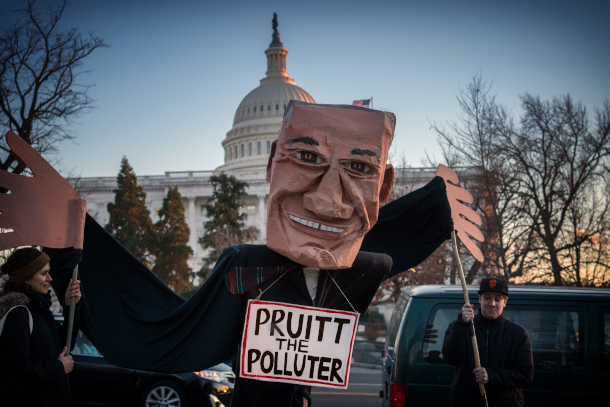
Former EPA Administrator Scott Pruitt was widely unpopular during his tenure, leading to protests in Washington, D.C. (Photo: Lorie Shaull, Wikimedia Commons, CC BY-SA 2.0)
CURWOOD: Yeah – a huge impact on climate change and those emissions have a big health toll, too.
LAVELLE: Right Steve. Now sometimes the rollbacks came back to bite Trump, such as when he dramatically shrank two national monuments in Utah, says Kristen Brengel of the National Parks Conservation Association.
BRENGEL: But notice what happened here is that they did Bears Ears and Grand Staircase and then stopped. They had about another dozen monuments on the list and they stopped the whole process because it was so wildly unpopular with the public. And so -- listen, people make mistakes, administrations certainly make mistakes. But that was a massive mistake.
DOERING: So how effective were Trump’s environment and climate moves?
LAVELLE: Well, they haven’t stuck. In 2021 the Biden administration immediately came in and got to work restoring those monuments, reinstating the rules Trump had rolled back, and re-entering the Paris Agreement.
DOERING: Well, so Marianne, what’s the lasting impact, here?
LAVELLE: For that you can look not to the executive branch but to the judiciary, according to Michael Gerrard of Columbia. The courts have become more and more friendly to these environmental rollbacks, thanks to the couple hundred federal judges Trump appointed to lifetime terms. And as you’ve probably heard, a few of those appointments are extremely important.
GERRARD: Well, Trump, of course, appointed three justices to the Supreme Court who are consistently voting against environmental regulation, we now have a six to three majority. And it has been systematically cutting back on environmental regulations.
LAVELLE: So, for example the court has shrunk wetlands protections and limited agency authority.
CURWOOD: Well, what can we look back on from the Trump administration that brought benefits for the environment or climate?
LAVELLE: Well, Kristen Brengel of the National Parks Conservation Association celebrated the bipartisan accomplishment of the Great American Outdoors Act, which President Trump signed.
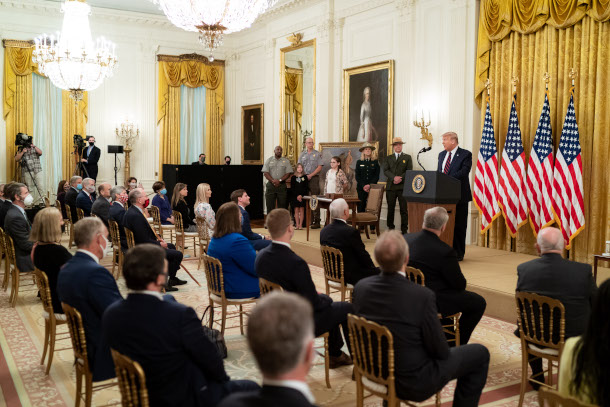
An important executive action related to conservation and public lands policy by President Trump was the signing of H.R. 1957, also known as The Great American Outdoors Act. He is shown here speaking before the formal signing. (Photo: The White House from Washington, DC, Wikimedia Commons, Public Domain)
BRENGEL: Hundreds of national parks, national forests are getting repaired even this summer thanks to this law. And so, on one hand, absolutely the Trump administration deserves credit for making sure that bill was as robust as it possibly could have been and signed into law. And the Biden folks deserve the credit for implementing it really well, and making sure our parks are going to be fit for the next couple of generations.
DOERING: So, let’s look ahead to the near future. I understand you got some perspective from these folks on what a second Trump presidency might look like vis-à-vis climate and environment.
LAVELLE: Yes, Jenni, here’s Michael Gerrard of the Sabin Center again.
GERRARD: We know that the Inflation Reduction Act, that money, has only marginal vulnerability to a new administration. And we know that the market forces are moving renewables forward at a fast pace. But we need regulations to shut down the coal fired power plants, and the other major fossil fuel uses. That depends in significant part on regulations. And these regulations are really in peril, thanks to the Supreme Court and the lower court judges appointed by Trump.
LAVELLE: So, Michael says it’s hard to overstate the impact on climate and environmental policy that this conservative shift has had. And what that could mean for a second Trump term.
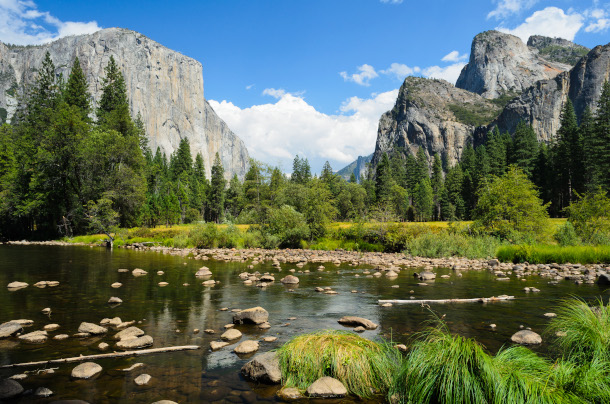
Valley View in Yosemite National Park. Yosemite, among many other national parks like Bryce Canyon, Death Valley, and Rocky Mountain, benefited from the Great American Outdoors Act with improvements to visitor facilities and infrastructure systems. (Photo: King of Hearts, Wikimedia Commons, CC BY-SA 3.0)
GERRARD: Well, if Trump comes back, it's gonna get a whole lot worse. If we look at the project 2025 report from the Heritage Foundation, which many people are looking at as a blueprint for what a second Trump administration would be, it would be the first Trump administration on steroids. They would continue the process of trying to revoke all those regulations. They would fight new renewables. And it would be “drill, baby, drill.”
CURWOOD: So, Donald Trump says he’s not tied to Project 2025, but in any event how does Mr. Trump plan to address the climate crisis?
LAVELLE: Well Steve, although we haven’t heard him call it an outright hoax in recent years, he has expressed no concern about what scientists are calling an existential crisis for humanity. And the 2024 Republican Party Platform which was directly shaped by Trump and his staff doesn’t even include the word “climate.” Tackling the climate crisis would certainly be at odds with the big plans the GOP and Trump have for fossil fuels.
DOERING: Yeah, you know, he had some glowing words for them on the final night of the Republican National Convention in Milwaukee, Wisconsin.
TRUMP: Remember we have more liquid gold under our feet than any other country by far. We are a nation that has the opportunity to make an absolute fortune with its energy. We have it and China doesn’t. Under the Trump administration just 3.5 years ago, we were energy independent. But soon, we will actually be better than that. We will be energy dominant and supply not only ourselves, but we will supply the rest of the world. [cheers]
Project 2025: "[NOAA] has become one of the main drivers of the climate change alarm industry and, as such, is harmful to future U.S. prosperity. ... [NOAA] should be broken up and downsized."
— Dr. Robert Rohde (@RARohde) July 17, 2024
Basically, they want to shoot the messenger https://t.co/x76zK4IeII
LAVELLE: And we noticed that Mr. Trump went off script during much of his speech, and he couldn’t resist taking a jab at the Inflation Reduction Act, the Democrats’ climate legislation.
TRUMP: And next we will end the ridiculous and actually incredible waste of taxpayer dollars that is fueling the inflation crisis. They spent trillions of dollars on things having to do with the green new scam, it’s a scam, and that’s caused tremendous inflationary pressures in addition to the cost of energy. And all of the trillions of dollars that are sitting there not yet spent, we will redirect that money for important projects like roads, bridges, dams, and we will not allow it to be spent on meaningless green new scam ideas. And I will end the electric vehicle mandate on day 1 [cheers] thereby saving the US auto industry from complete obliteration which is happening right now and saving US customers thousands and thousands of dollars per car.
LAVELLE: To be clear, there is no electric vehicle mandate. And it’s unclear how a Trump administration would repeal the grants, loans, and tax credits of the Inflation Reduction Act without new legislation in Congress. He’d need Republican control of the House and Senate, so even though this presidential election is getting most of the attention now, Steve, we can’t forget about those down ballot races, too.
CURWOOD: That’s right, Marianne. Marianne Lavelle reports for Inside Climate News from the nation’s capitol. Thanks so much!
DOERING: Thanks, Marianne!
LAVELLE: Thanks, Steve, thanks, Jenni!
Related links:
- Read more from Marianne Lavelle on Donald Trump’s Eco Record
- Watch Donald Trump’s Speech at the Republican National Convention
- Listen to our analysis of J. D. Vance, Donald Trump’s running mate
[MUSIC: Queen Under Pressure, David Bowie & Queen on Hot Space 1982]
Listener Comments
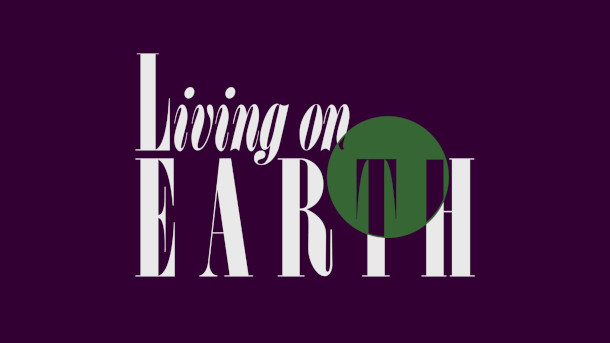
Living on Earth listeners are encouraged to reach out to us at our comments email, comments@loe.org.
CURWOOD: Our lengthy interview with Republican Congressman Cliff Bentz of Oregon last week prompted several comments from you, our listeners. Some wanted a more confrontational exchange. One wrote, “Maybe you could get an interviewer who knows how to push back if you're hosting a show about the environment and inviting Republicans on the air to cover all their talking points.” Adding “I've never been as shocked to hear an interview on public radio, typically considered "liberal leaning", and during an environmental program at that. Caving to Trump's bullying tactics that the media is biased isn't going to win you more viewers.” For the record, we cover relevant and accurate news and information from across the political spectrum --left, right and center and have never caved to bullying tactics by those opposed to truth in environmental reporting.
Larry Cooper offered a more measured critique: “Thank you for the interesting episode on the Republican Party. As an Oregonian, I was particularly interested in the Bentz interview. A lot of interesting things came up in that interview that really need some follow up to present more of the facts.... First of all, I was struck by Bentz's very confusing and contradictory comments over drafting of groundwater. On the one hand, he decried overuse of very deep wells, yet there are thousands of acres of hay being grown with this water in his district. Secondly, his discussion of dam removal and salmon seemed a total disconnect from reality. Dams block a tremendous amount of anadromous fish habitat, and there's no question that the salmon would be helped with dam removal. On top of that, there are alternatives to generating clean, storable energy in the region. Bentz goes further to claim that not enough is being done to mitigate predation of fish in the ocean! Yes, but hardly an argument against improving river habitat. You could do a good show looking at the indigenous tribal projects that are restoring stream flows and improving aquatic habitat in Bentz's district.... Thirdly, Bentz should be called out regarding his stance against federal protection of the high desert. We have some wonderful national monuments there and they DO do mitigation of invasive weeds. And of course his legal career has been greatly enhanced with the Chevron take down by the Supremes.... Thanks for a good show.” And thank you Larry, for your comments.
And I’ll comment here. A key cornerstone of American democracy is the freedom of speech, and I am reluctant to censor the stated opinions of public officials that some, maybe even many listeners to this program find unattractive. Fact checking is important, as you heard a while ago when we ran part of former President Trump’s convention speech. We fact checked his comments as we don’t care to broadcast “alternative facts.” But the line between fact and opinion can be blurry sometimes and people are certainly entitled to their own opinions. And as citizens in a democracy, we need to hear opinions from a wide range of sources, even if sometimes we don’t want to hear them, so we can better discern our own. President Thomas Jefferson once said we need a free press and free discourse to be free, and I quote: “Were it left to me to decide whether we should have a government without newspapers, or newspapers without a government, I should not hesitate a moment to prefer the latter.”
Related links:
- Email Us at comments@loe.org
- Oregon Public Broadcasting | “The Search for Solutions to Harney County’s Water Crisis”
- Oregon Public Broadcasting | “Leaked Agreement Shows Federal Government Willing to Take Down Snake River Dams”
[MUSIC: Duke Ellington “Satin Doll” on Jazz Party, Sony BMG Music Entertainment]
Water! Falls!
A waterfall above the Arctic Circle in Edgeøya, an island in the southeast of Norway’s Svalbard archipelago. (Photo: © Mark Seth Lender)
DOERING: Earth is a planet in motion where water carves deep canyons and rock itself turns to liquid. And that got Living on Earth’s Explorer in Residence, Mark Seth Lender thinking.
Water! Falls!
© 2023 Mark Seth Lender
All Rights Reserved
There is something about waterfalls, and volcanoes, that makes me think of them in the same way. Why? It took me a while. When I pose this as a question people say, it’s the Power. Which is true but that applies equally to the sea, especially in storm when the waves are crashing. And all that violence. But I don’t think Ocean/Volcano, or Ocean/Waterfall holds together in the same way as Waterfall/Volcano.
Waterfall/Volcano is different.
Rock is dense and cold and solid and it sinks. It stays put. Water is forgiving and pliant. It turns into mist. It returns, as rain. In a waterfall, it is the water that sinks. That falls. Not the rock over which it cascades. In a volcano, rock instead of being solid and cool is molten and hot. Ejected, into the stratosphere, rock defies its very nature!
That’s the relationship. Water that falls like something solid; rock that is liquid and flings itself into the air.
When I look at a waterfall it brings that opposition in mind, for me. Naming, saying “Waterfall” all-at-once, like that, that loses these oppositions and contradictions. Instead think, “Water, Falls.”
The Skógafoss waterfall in Iceland. (Photo: © Mark Seth Lender)
And really see:
Water of the rushing river gathered from a source unseen. Water only of the moment from spring melt, from storm sabered by lightning. Each source, and every waterfall that it feeds, is different. Water that was glacier, its blue ice and black ice creaking and splintering against the agency of unnatural demise…
So next time you look at a waterfall, say it out loud, this way:
Water! Falls!
DOERING: That’s Living on Earth’s Explorer in Residence, Mark Seth Lender.
Related link:
Mark Seth Lender’s website
[MUSIC: TLC, “Water Falls – Album Instrumental” on Waterfalls (Remixes), Sony Music Entertainment]
DOERING: Just ahead, Scientists consider the notion of plant intelligence. That’s coming right up on Living on Earth. Stay with us!
ANNOUNCER: Support for Living on Earth comes from Friends of Smeagull the Seagull and Smeagull’s Guide to Wildlife. It’s all about the wildlife right next door to you! That’s Smeagull, S - M - E - A - G - U - L - L, SmeagullGuide.org.
[CUTAWAY MUSIC: Miles Davis, “Freddie Freeloader” on Kind Of Blue, Sony Music Entertainment]
The Light Eaters
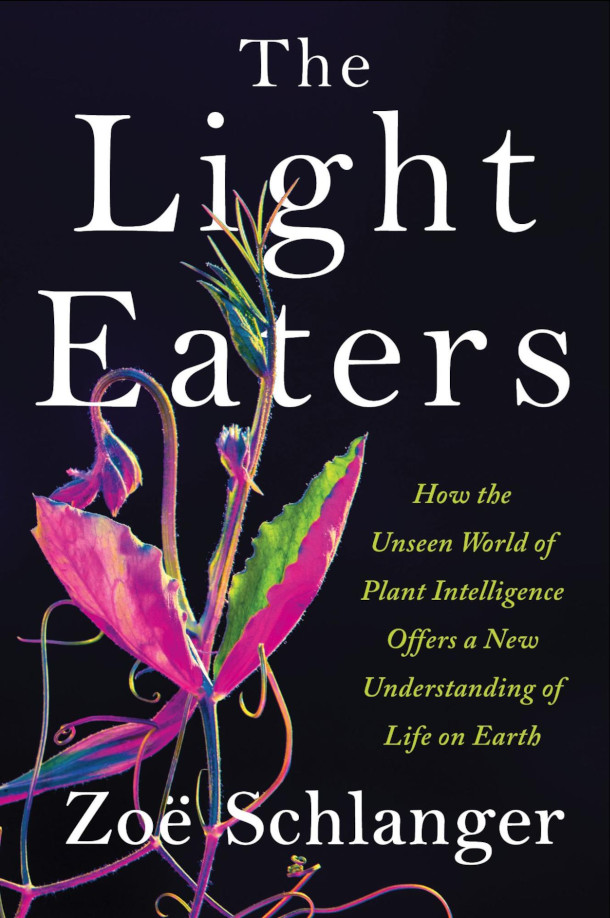
Zoë Schlanger’s book The Light Eaters: How The Unseen World of Plant Intelligence Offers a New Understanding of Life on Earth delves into topics like plant sensation, communication, sociality, and intelligence. (Photo: Courtesy of HarperCollins)
DOERING: It’s Living on Earth, I’m Jenni Doering.
CURWOOD: And I’m Steve Curwood.
A scientist who rappels down cliffs to hand-pollinate endangered plants. A vine that mimics the leaves of nearby species. Rice that crowds out strangers but leaves room for the roots of relatives. All of these are subjects of the book The Light Eaters, by Zoë Schlanger, who tackles big questions of plant intelligence, consciousness, and communication. Welcome to Living on Earth, Zoe!
SCHLANGER: It's so great to be here.
CURWOOD: So, early in your book you write, "I was regaining material intimacy with the natural world by looking at plants. It wasn't a way to ignore environmental catastrophe, it was a way to reattach myself to the stakes." So how can studying plants change our perspective of the climate emergency we're in right now?
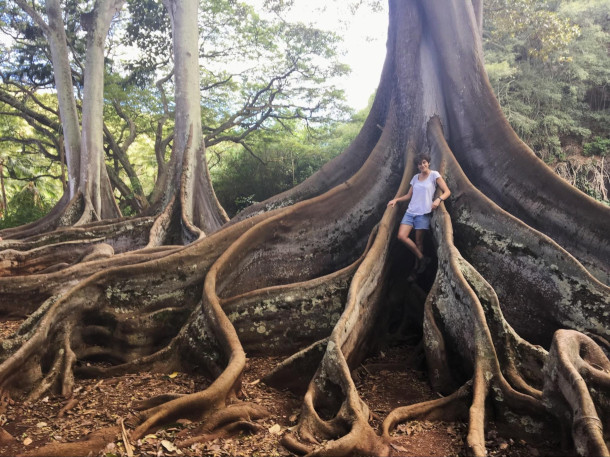
Author Zoë Schlanger stands by a Moreton Bay fig tree at National Tropical Botanical Garden in Kauai, Hawaii. It can be humbling to remember that every molecule of glucose we’ve ever consumed was first created by a plant through photosynthesis. (Photo: Gloria Dickie)
SCHLANGER: So I'm a climate reporter. And I came to this project out of feeling quite numb and fatigued, as many of your listeners probably also feel, about all of the bad news related to climate change. And I think the biggest takeaway for me of studying plants for the last several years was the incredible creativity that exists in biology and evolutionary trajectories, and the ways that plants make a living exactly where they're rooted in place. They find ways to thrive against all circumstances, despite not having brains, in incredibly cunning ways. And I think as it relates to my own kind of muddled feelings and numbness around climate change, it really reminded me of the worth of trying to protect as many species as possible, because every single one of these is a remarkable feat of ingenuity from a biological standpoint. And it really helped me expand my mind beyond the few plants that we actually use in our human economies to just actually have this appreciation for all plant life. And it's very humbling to remember that we're also entirely dependent on them. You know, every molecule of glucose we've ever consumed was first made by a plant; it made it through photosynthesis, through sunlight and water and air. So it really rearranges one's sense of where you are in the so-called hierarchy of life and reminds you that life finds a way.
CURWOOD: So as you point out, plants don't have brains. And yet, you've written a book about plant intelligence. Square that circle for me, please.
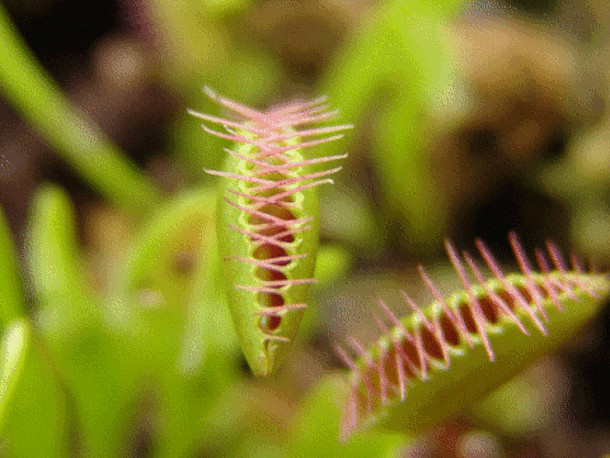
When an insect (or a toothpick) touches the hairs on a Venus Fly Trap’s mouth-like leaf, it provokes an electrical signal that triggers the leaf to close. (Image: Mnolf, Wikimedia Commons, CC BY-SA 3.0)
SCHLANGER: Sure. I mean, this is the million-dollar question. Scientists are understanding now that plants are able to respond in remarkably dynamic ways to their environment and make good choices for their future. They're able to record information about the past and use it in their decision making. They can sense their kin, they can communicate, all of these incredible things. And they do it all without a brain. And no one has answered the question yet of how all of this information is integrated in a plant body without centralized processing. But there's actually really good evolutionary theory for why a plant wouldn't produce a brain but might be able to do remarkable things regardless. We evolved a brain in part because we had to move across long distances to gather food, to flee from threats, we needed something really compact and portable. Plants, on the other hand, had none of those particular constraints. They had other ones. They needed to be able to stay in one place, but also sense their environment and also easily lose a limb or two when it called for it, without being damaged in some major way. So you end up with this kind of decentralized, modular creature that somehow is able to still integrate information across its whole body, to make good choices about where to grow, and how to find food. So that is really this huge open question of how they integrate this information without a brain.
CURWOOD: At one point, you make a comparison to the brains that animals have and the, the number of neurons and everything in their brain versus what plants have for ways to sense what's going on around them.
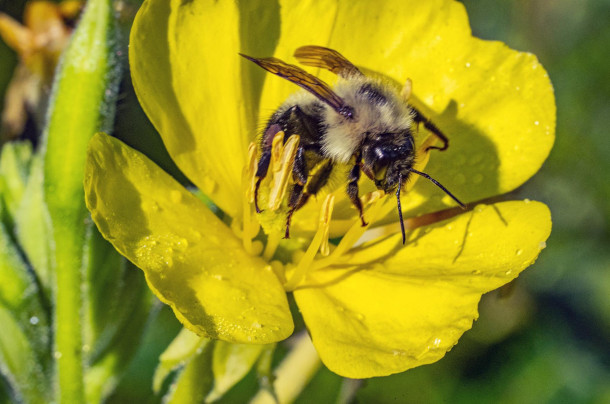
The evening primrose will increase the sweetness of its nectar when it vibrates at the same frequency as a bee buzzing. (Photo: Steve Guttman NYC, Flickr, CC BY-NC-ND 2.0)
SCHLANGER: Yeah. Well, it's important to mention that plants do not have neurons, there's no synapses, there's not nervous conduction in the literal sense that we think of with our own brain and our own bodies. But there is electricity moving through a plant body. And there's been plenty of work finding that certain activities in plants are mediated by electricity in the sense that a Venus flytrap, when it closes, it's because these little trigger hairs on the inside of its maw, its mouthlike leaf, have been flicked by a wriggling fly or whatever it's just caught. And each one of those little flicks is associated with a flash of electricity, an action potential. And that's what triggers the trap to close. So there are somehow ways for this plant to experience the phenomena of touch and respond to it in kind. There's chemicals being exuded that the plant can emanate from one branch, and then another branch of it can absorb those chemicals and register them as information. So there's no brain, there's no neurons. And yet there is this whole-body connectivity that we see in plants, which is quite remarkable.
CURWOOD: Let's go back to the 1970s, when an influential book called The Secret Life of Plants was published. What was the impact, do you think, of that book? And how did it shape your approach to writing this book?
SCHLANGER: The Secret Life of Plants absolutely haunted every single day of reporting on this book, because you can't talk to a botanist now who doesn't acknowledge the way that it tanked the field for a full generation. This book was incredibly influential. Never before had a work of botany broken onto the popular scene so powerfully. I mean, there was a feature film, Stevie Wonder wrote the soundtrack, it's a very good soundtrack. And this is where people began talking to their plants, or had the idea that plants enjoyed classical music more than rock and roll, all these pretty pseudoscientific ideas that were inside this book.
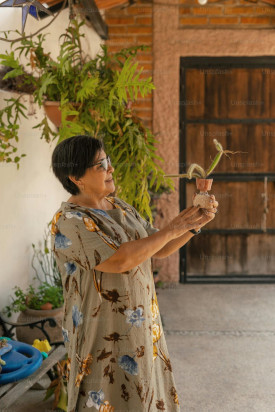
The book The Secret Life of Plants, published in 1973, popularized the idea that it is beneficial to talk to your plants, and that they prefer classical music to rock & roll. There is little evidence to support these ideas, but plants do respond to sounds, such as that of a bee buzzing or a caterpillar chewing. (Photo: Jordan González, Unsplash, Unsplash+ license)
CURWOOD: So wait - is that pseudoscientific, that there might be a response to us talking to our plants?
SCHLANGER: As far as I know, there's no reason a plant would respond to us talking. Although there's amazing work being done now in the world of phytoacoustics in terms of plants responding to sound. They certainly do, but more likely it's sound that's ecologically relevant to the evolutionary history of that plant. We've only been with plants for a mere few thousand years; plants have been evolving for millions and millions of years. So it doesn't make a lot of sense for them to be responsive to our talking, although probably if you talk to your plants, it means you're a much better plant parent than you would be otherwise, and they probably love that.
CURWOOD: What about singing to them, or banging a drum, which would go back thousands, millions of years?
SCHLANGER: That would be an interesting thing to test out. I mean, what we do know is plants can respond to the sound of a caterpillar chewing, or a bee buzzing, and will make adjustments. Evening primrose will increase the sweetness of its nectar by three times very quickly, when it starts to vibrate at the same frequency as a bee flying by or buzzing. Plants are very receptive to vibration. It's a physical stimulus. So to them sound is pure vibration. So who knows? I mean, there's probably a lot of sounds that plants are receptive to.
CURWOOD: And plants can feel pain, or at least they send out signals indicating that they've been pinched. Please describe the experiment that demonstrated that to you.
SCHLANGER: Yeah. Well, to be super clear, there's nothing to suggest they can experience pain in the way that we experience pain, as this like displeasing sensation. But we do know that when a plant is injured, when it's, let's say, clipped, or bitten by a predator, or bent, that will produce a flurry of defensive chemicals to make itself either less palatable, make its leaves very bitter, or send out warnings to other plants in the area that there's an attack underway. Or at least those plants are able to pick up on those chemicals from that injured plant and recognize that they have to boost their own immune systems. So certainly plants produce strong reactions to being hurt. And I think about this now every time I touch a houseplant. I was able to go to a, a lab in Wisconsin that is working with plant wounding experiments, and they've imbued these plants with these fluorescent green proteins from jellyfish. And those proteins are attached to calcium, which is typically seen as a precursor or like a signal that there's some electricity moving through a cell. And so they handed me tweezers, we're in this dark microscope lab, and I pinch the plant with the tweezers, and suddenly there's this green eminence glowing from the place that I've pinched this plant, then it starts traveling down its vein system. And within about two minutes, the entirety of this little plant had received the signal of my pinch.
CURWOOD: Well, and in the course of this experiment, they had to encourage you to pinch harder.
SCHLANGER: It's true. Yes, I mean, think about it, you've just been told that plants can feel you touching them, and then you're expected to enthusiastically wound this plant. It felt like the vegetal version of the Milgram shock experiment. But then I remembered, of course, I eat salad, it's okay. Pinch the plant. And, and I did and it was pretty spectacular to see.
CURWOOD: Speaking of eating salad, though, what does your work tell us about veganism? I mean, what moral superiority is there in just eating plants if plants are sentient beings as well?
SCHLANGER: I think it's a really interesting question, because we are animals that have to eat plants, there's no way around it. We need their sugars and proteins to keep ourselves alive. But it does start to bring into conversation this idea that, well, maybe every living thing is bent towards life and wants to keep living. And plants are no exception to that. I mean, it's interesting to try to have to hold in your mind that you, in order to survive, have to enact some violence on an organism that wants to keep living. And what does that mean? I mean, maybe it can introduce a sense of profound gratitude, or respect, or reciprocity with other creatures, and maybe that can shape how we treat them.
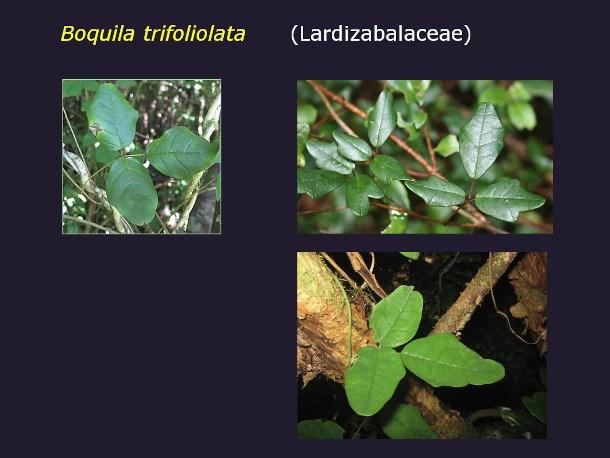
The vine boquila trifoliolata is known to mimic the leaf shape, texture, and color of nearby plants. These images show boquila leaves in their “original” state, not mimicking other plants. See below for images of boquila engaging in mimicry. (Photo: Courtesy of Ernesto Gianoli)
CURWOOD: So to what extent does your work suggest that plants have consciousness?
SCHLANGER: Well, consciousness is this incredibly alluringly mushy concept. We don't know the mechanical basis for consciousness even in ourselves. We can't verify the consciousness of anyone but ourselves. It's something we feel, but it's extremely hard to pin down. And consciousness in some ways could be seen as simple as the capacity to take control of one's life and guide one's actions according to your best abilities, a sense of experiencing the world. And these are not outside of the realm of things that you can consider plants doing if you look at them a certain way, if you look at all of the science coming out and holding in mind that there are realms of thought that believe that consciousness began with the very first cell even. So we're deep in the area of theory here, and there's no easy answers, but it at least is an intriguing thought experiment that I think could really rustle us out of this kind of sense of human superiority in this realm.
CURWOOD: So throughout your research process for this book, you traveled around the world and met a whole cast of, of characters. What was that like? And talk to me about one of your favorite characters from this.
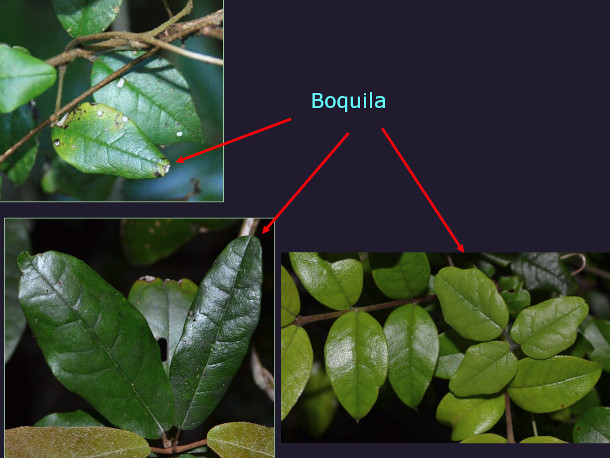
The leaves of boquila trifoliolata mimicking those of other plants. Scientists have differing theories about what enables this mimicry. Some believe that boquila is processing visual information about its neighbors. Botanist Ernesto Gianoli thinks boquila may be interacting with the microbiomes of other plants. (Photo: Courtesy of Ernesto Gianoli)
SCHLANGER: Botanists are some of the most wonderful scientists to talk to, in part because they have so much feeling for organisms that many of us maybe ignore, perhaps in favor of animals. I mean, I think about the fact that most of us can tell the difference between like a codfish and a toucan or something, but we can't tell the difference between wheat and rye, which are incredibly different species themselves. So these are people who have profound connections to these much-ignored organisms. And their research is also mind-blowing. One of my favorite trips was to the southern rainforests of Chile, these temperate rainforests, kind of chilly, wet places. And there is a vine that grows in this rainforest called boquila trifoliolata. And this vine has, of course, always been there, at least for human memory. But it was just recently discovered to be quite literally a chameleon vine. It can spontaneously change the shape of its leaves, the color of its leaves, the vein pattern, the texture, to match the shape, to mimic the shape of anything it's growing beside. This plant can mimic up to four different species at the same time, with different parts of its vine structure. And no one knows how this is possible. So I spent several days with the team of Ernesto Gianoli, a researcher who's studying this plant, and the vine has provoked this controversy over whether or not plants could possibly see. There are a camp of botanists who say, well, it's mimicking, spontaneously mimicking other plants--that must be a form of visual acuity, that they're taking visual information and processing it and producing this perfect mimic. But of course, plants don't have brains. So where would they be transposing that visual information into an image in the way we think of it? But plants do have a ton of photoreceptors on their leaves, more than we have in our eyes, more different types of photoreceptors. So there's some weight behind that argument. And then, the botanist himself who I was spending time with thought it was something far more sci-fi, that this plant was actually just receptive to the microbiomes of other plants, that the shape of plants is not determined by the plant itself, but rather by sort of third-party organisms. I mean, we talk a lot about the human microbiome and all these other creatures that live on and inside of us that dictate certain things about our own behaviors, let's say our mood, or our, our gut health. And he thought, well, maybe it's some kind of microbial takeover in that way. And this vine was just more receptive to that of other species.
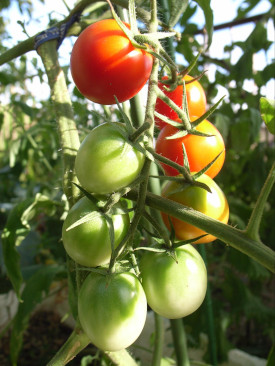
Tomato plants can sense the particular species of caterpillar that is chewing on them, then emit chemical signals to attract a wasp that parasitizes that caterpillar. (Photo: Toshiyuki IMAI, Flickr, CC BY-SA 2.0)
CURWOOD: So if you wouldn't mind, if you could open your book to page 183. So you're talking to the scientist Gianoli, and if you could pick up with that line, "We sit down on a log."
SCHLANGER: "We sit down on a log covered in pink and orange slime molds. Gianoli talks about the fact that termites were recently discovered to have microbes in their guts that make it possible for them to digest the chemicals in wood. In other words, the most signature behavior of termites--wood eating--is made possible by entirely different organisms living within them. The termite's gut microbes, in turn, are able to function thanks to yet smaller microbes that live within them. The presence of these animals-inside-animals predates the evolution of the termite itself--some termite ancestor likely acquired them by eating dead plant material where microbes were living. From there, both evolved together into the versions of each that exists today. One species of Australian termite is known to have a protist in its gut that in turn carries around four types of bacteria of its own. So many cascading individuals make a termite possible. 'They're independent, they're from different families, it's crazy,' Gianoli said. Over and over, the thrust of these new discoveries points in the same direction: a termite is never just a termite. The same is clearly true for every organism."
CURWOOD: Zoë, this theme of organisms being not just individuals, but a part of a larger ecosystem, this comes up a lot in your book. Tell me more about that.
SCHLANGER: Well, very quickly into researching this book, which is very firmly about plants, I realized it's really hard to tell where a plant starts and where a plant ends, because a plant is so hooked into and influenced by so many other organisms. I mean, fungi, for example, are entwined in the roots of virtually every single plant grown in the wild. And they're so a part of plants that some have posited that roots first evolved simply to house fungi. And they're interacting with microbes and viruses and molds, any number of other organisms all the time. It really is shaking the core of the idea of a biological individual. I mean, our selves are not biological individuals--something like half of our cells belong to other organisms, have foreign DNA. And they may well be influencing things we think of as wholly the domain of our own bodies, things like our health, things like our mental state. We are not just one creature, we are highly dependent on and enmeshed with so many others.
CURWOOD: So what were some of the most surprising things, beyond the things we've already talked about, that you learned when you were researching this book?

Zoë Schlanger is a reporter at The Atlantic and the recipient of a 2017 reporting award from the National Association of Science Writers. (Photo: Heather Sten)
SCHLANGER: I loved learning about the ways that plants can manipulate other creatures, even animals. They are able to kind of take the reins of a lot of other organisms. Plants have this entirely separate sense that we have none of, essentially, that is chemical synthesis. They are able to produce chemicals in their bodies that they then let out through pores on their leaves that infiltrate the bodies of others and make them do things. And so one example of this is the humble tomato plant. The tomato plant is able to sample the saliva of a caterpillar chewing on it, and from there, make a chemical that will summon the exact predatory wasp that will want to come inject its eggs into this caterpillar, and the eggs will then hatch, and the larvae will eat the caterpillar from inside out and glue its little white cocoons to the outside of this husk of a caterpillar. And this is how this tomato plant attempts to defend itself from the hungry mouths of a million caterpillars. It's really remarkable when you think about a plant manipulating an animal, it really turns a lot of ideas upside-down.
CURWOOD: So what does studying plants tell us? What's the message?
SCHLANGER: Well, I can only say what learning all of this has done for me. And at a very simple level, these findings, these scientific developments around plant behavior, produce this immense feeling of awe, at least in me. And I know Rachel Carson wrote about this a bit towards the end of her life, and many people have studied this, that the experience of awe leads directly towards respect and sort of away from negligent behavior or away from indiscriminate destruction. And injecting ourselves with a big dose of awe could only do good things both for addressing climate change and just for being animals in this world.
CURWOOD: Zoë Schlanger's book is called The Light Eaters. Zoë, thanks so much for taking the time with us today.
SCHLANGER: It's been wonderful talking with you. Thank you.
Related links:
- Find a copy of The Light Eaters (Affiliate link helps donate to LOE and local indie bookstores)
- Learn more about author Zoë Schlanger
- Zoë Schlanger’s profile at The Atlantic
- New York Times | “Are Plants Intelligent? If So, What Does That Mean for Your Salad?”
[MUSIC: Keith Jarrett Trio “Poinciana – Live At Palais Des Congres, Paris / 1999” on Whisper Not, ECM Records GmbH]
DOERING: Just ahead, Scientists consider the notion of plant intelligence. That’s coming right up on Living on Earth. Stay with us!
ANNOUNCER: Support for Living on Earth comes from Friends of Smeagull the Seagull and Smeagull’s Guide to Wildlife. It’s all about the wildlife right next door to you! That’s Smeagull, S - M - E - A - G - U - L - L, SmeagullGuide.org.
[CUTAWAY MUSIC: Miles Davis, “Freddie Freeloader” on Kind Of Blue, Sony Music Entertainment]
CURWOOD: Coming up this fall, the story of George Woodwell, the giant among scientists who helped start the Natural Resources Defense Council, The Environmental Defense Fund, and inspired me to launch this show back in 1990. George advised presidents from Jimmy Carter to Barack Obama, and helped create the UNFCCC, the world’s climate treaty—all as he led cutting edge research.
RAMAKRISHNA: Another thing that he was very fond of saying is that the role of the government is to define and defend public interest. And the question, of course, is how do you come to the conclusion and what's in public interest? And that is where he said, Well, you have to rely on science. And so that's where I think George stands out amongst all of his great luminary scientists, colleagues that he has.
CURWOOD: Tune in this fall to hear the amazing story of George Woodwell, the late environmental science and public policy genius.
[MUSIC: Keith Jarrett Trio “Poinciana – Live At Palais Des Congres, Paris / 1999” on Whisper Not, ECM Records GmbH]
CURWOOD: Living on Earth is produced by the World Media Foundation. Our crew includes Naomi Arenberg, Shanzay Asif, Paloma Beltran, Kayla Bradley, Josh Croom, Karen Elterman, Daniela FAH-ria, Swayam Gagneja, Sommer Heyman, Mark Kausch, Mark Seth Lender, Don Lyman, Nana Mohammed, Aynsley O’Neill, Sophia Pandelidis, Jake Rego, Andrew Skerritt, El Wilson, and Jolanda Omari.
DOERING: Tom Tiger engineered our show. Allison Lirish Dean composed our themes. You can hear us anytime at L-O-E dot org, Apple Podcasts and YouTube Music, and like us, please, on our Facebook page - Living on Earth. We tweet from @livingonearth. And find us on Instagram at livingonearthradio. And you can write to us at comments at loe dot org. I’m Jenni Doering.
CURWOOD: And I’m Steve Curwood. Thanks for listening!
ANNOUNCER: Funding for Living on Earth comes from you, our listeners, and from the University of Massachusetts, Boston, in association with its School for the Environment, developing the next generation of environmental leaders. And from the Grantham Foundation for the protection of the environment, supporting strategic communications and collaboration in solving the world’s most pressing environmental problems.
ANNOUNCER 2: PRX.
Living on Earth wants to hear from you!
Living on Earth
62 Calef Highway, Suite 212
Lee, NH 03861
Telephone: 617-287-4121
E-mail: comments@loe.org
Newsletter [Click here]
Donate to Living on Earth!
Living on Earth is an independent media program and relies entirely on contributions from listeners and institutions supporting public service. Please donate now to preserve an independent environmental voice.
NewsletterLiving on Earth offers a weekly delivery of the show's rundown to your mailbox. Sign up for our newsletter today!
 Sailors For The Sea: Be the change you want to sea.
Sailors For The Sea: Be the change you want to sea.
 The Grantham Foundation for the Protection of the Environment: Committed to protecting and improving the health of the global environment.
The Grantham Foundation for the Protection of the Environment: Committed to protecting and improving the health of the global environment.
 Contribute to Living on Earth and receive, as our gift to you, an archival print of one of Mark Seth Lender's extraordinary wildlife photographs. Follow the link to see Mark's current collection of photographs.
Contribute to Living on Earth and receive, as our gift to you, an archival print of one of Mark Seth Lender's extraordinary wildlife photographs. Follow the link to see Mark's current collection of photographs.
 Buy a signed copy of Mark Seth Lender's book Smeagull the Seagull & support Living on Earth
Buy a signed copy of Mark Seth Lender's book Smeagull the Seagull & support Living on Earth

